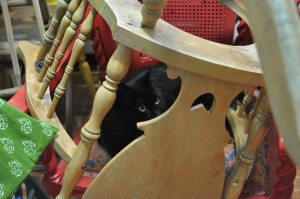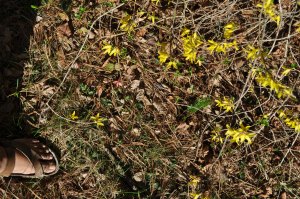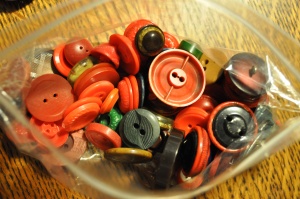 In my teenage years I used to retort “I’m not really reading” when my disciplined and cultured mother would say “Either light a lamp or get out of that dark corner with that book.” And now, confronting the reality of usable space in the house, of my aging joints, of my available time, etc. etc. I’ve embarked on downsizing my decades-old pile of papers, fabric, toys and clothes. Naturally, a perky cartoon figure of the mind pipes up and inquires “Why don’t you blog about it?” The following are my retorts to it:
In my teenage years I used to retort “I’m not really reading” when my disciplined and cultured mother would say “Either light a lamp or get out of that dark corner with that book.” And now, confronting the reality of usable space in the house, of my aging joints, of my available time, etc. etc. I’ve embarked on downsizing my decades-old pile of papers, fabric, toys and clothes. Naturally, a perky cartoon figure of the mind pipes up and inquires “Why don’t you blog about it?” The following are my retorts to it:
1. The temptation to fib is enormous.
2. My house will still look cluttered by anyone else’s standard when I am through. It is a workshop and library, not just a place to park myself at the end of the day-job day.
3. My job as a teacher, and the rest of life, will not allow me to work continuously on the project, though I do chip away at it daily.
4. What I keep and what I let go of may make no sense to anyone else–here is where the writing comes in, little scribbles of conjecture and command to keep myself going. Notes and hand-drawn charts are my handrail up this slippery slope. I’ve lived in a dozen places–my things, my insensible things, are my roots. (Sorry explanation, of course.) My books I won’t even explain past saying that I’d have to be near one of a limited number of large university libraries to have access to similar things. I’ve given up my old plan to make patchwork quilts or collages out of every scrap (what can I say?– I was a stay-at-home parent/ artist), but the principle of eking the story out of what’s left remains.
A winter-break (our strange February holiday, for non-New-Englanders) exchange with teenager is to the point here:
Young Person: These night gowns are really gross. The front of this one is all gray. And this one is just a rag.
Me: The color supposed to be lavender. Knit fabrics don’t keep very well. Those are nightgowns from when you were born. I cut off that one because it was comfortable but I wanted to wear pajamas with it. We used the bottom half for cleaning rags.
Young Person: Well, maybe you should keep one then–if they’re historic.
Me: Nah. They really need to go.
Young Person: Then go write 500 words about them.
Me: OK. This is very appropriate use of your innate bossiness.
And really, folks,the textile me says: cotton knits are comfy because they are light and stretchy like skin. Ironing them to interfacing and making quilts out of them is the most perverse craft idea I ever heard of! Do you preserve the skins of every chicken or fish you’ve eaten? No matter how clean your t-shirts and knit gowns are when you put them away, they get to smelling like dirty socks when they are stored in boxes. I think they preserve some essence of your life and activities–and why not? They are the last step before nudity for most of us. You can bleach them and sun them, but then they fall apart even faster. Think of knit cottons as clean bandages and not clothing, a daily bit of textile life that will not get woven into the tapestry of the ages except as a scent or an idea. And that leaves me here: I have to take the wild chance that I will remember my strapping young roommate as a bald-headed wriggling baby in my arms in that wee rented house of yore, or I won’t. (She had her own knit cottons, of course, but she grew out of them in such record time that those tiny shirts and onesies were worn by several other babies afterwards.) I will remember my mother indulging me with nightgowns in my favorite colors, or I won’t. I will remember my father–the grandfather of big-headed newborn–ordering me and baby off the thick futon on the floor so it could go on the wooden frame, or I won’t. My memories themselves, written or pictured, will become someone else’s clutter. Digitizing them to get them off the floor is not good enough, as it turns out. (See http://www.theguardian.com/technology/2015/feb/13/google-boss-warns-forgotten-century-email-photos-vint-cerf).
I also just ripped up into dust rags the handwoven purple striped tablecloth that faded in the Banaras sun on my little study table; I took notes on the arcane poetry that was the subject of my doctoral dissertation while sweating into it. All that truly feels like another life, but of course those times made me a different person for the rest of my life. The strictness and chaos of that ancient pilgrim town layered with squawkingly aggressive commercialism, the unknown sea of “dissertation” that I had innocently waded into, both colored and hardened me, the me that is now sitting in this chair typing in a break between the snowstorms of this winter in Maine. The light lines through the deep, muddy purple of my tablecloth were like lines in a notebook. The fabric is so weakened now that even gripping one edge in my teeth ripped out tiny patches. The tougher red border tore off as one long piece which I’ve offered to my spouse as a rag for trombone neti. Relatives still living in South Asia are so pragmatically used to this process that instead of trying to save old curtains and spreads “for the memories”, they give them away or rip them up with alacrity. Only fancy clothes are sometimes saved for future generations.
4. I no longer WANT anyone’s opinion on what to keep and what to give away. Even my friends have been frequently in the wrong on this score. My mother possibly understands my immigrant’s aesthetic ties to Indian fabric, and but what about the *American* things? Having been through historical and geographical upheavals herself, she understands the need to preserve, but maybe she doesn’t even know what’s in my college notebook boxes…although I think she has a trunkful of wonder-struck and sophomoric letters I sent her back then, written in immaturely slanting longhand on lined paper.
5. The word “chuck” indicates waste to me. I certainly take part in our insane consumption, but it’s always made me nervous. Recycle, repurpose, donate to the right group: that’s where I want to be active. “Trade” and “sell” have not worked out very well since we seem to live on an elliptically looping minor planet at the edge of the universe. Give, give, give–that really is the cure for “keep, keep, keep”. “I kept it for you” is a good silent explanation when I hand someone something I’ve kept for years–the words often turn out to be genuine in an unexpected way. Why else would I have sewing patterns in sizes that don’t fit me (or now) anyone else in the immediate family? Heart-shaped plastic beads? Needlepoint needles with deliberately flattened tips?
 First Sandal Day–reminds me of “First Neighborhood Bank.” Somewhere, there actually IS a “Second Federal Bank and Trust”–I think I’ve even seen one, and being made of brick and plaster, surrounded by the trim bushes that marked out financial institutions in the Southern town of my teenage years, it couldn’t have been a joke. But which sad people would CHOOSE Second, or Fifth, Federal Bank and Trust if they could deposit their hard-earned savings in the First? In the same way, we all know that the rest of elasticated time will never be as memorable as the first day we do something.
First Sandal Day–reminds me of “First Neighborhood Bank.” Somewhere, there actually IS a “Second Federal Bank and Trust”–I think I’ve even seen one, and being made of brick and plaster, surrounded by the trim bushes that marked out financial institutions in the Southern town of my teenage years, it couldn’t have been a joke. But which sad people would CHOOSE Second, or Fifth, Federal Bank and Trust if they could deposit their hard-earned savings in the First? In the same way, we all know that the rest of elasticated time will never be as memorable as the first day we do something.
